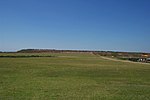Malabar Battery

Malabar Battery was a coastal defence battery built in 1943 during World War II at Malabar Headland in Sydney, Australia. The battery is also known as Boora Point Battery. The battery was constructed to complement the existing coastal defence batteries at nearby Henry Battery, Banks Battery and Bare Island Fort. Two 6 inch Mark XII guns in gun emplacements on mountings were constructed at the battery. An underground counter bombardment facility, with gun crew ready rooms, ammunition supply and engine room together with a narrow-gauge tramway which was cut into the sandstone and lined with sandstone and a large battery observation post were also constructed at the battery.The tramway was a single track of 560mm (22 in) and was to transport the 6" projectile munitions to the shell expense stores/magazines in the base of each gun emplacement. The tramway traverses through a deep continuous cutting lined with sandstone leads from the ammunition drop off point to the basement of the ammunition supply room and up to the two gun emplacements. Before reaching the gun emplacements the line enters a rectangular section concrete tunnel which is 94 m (310 ft) long.Also constructed as part of the battery were northern and southern searchlight blockhouses with associated engine rooms and the battery barracks and toilet blocks. Following decommissioning of the gun emplacements after the war, the site fell into disrepair.
Excerpt from the Wikipedia article Malabar Battery (License: CC BY-SA 3.0, Authors, Images).Malabar Battery
Fishermans Road, Sydney Malabar
Geographical coordinates (GPS) Address Nearby Places Show on map
Geographical coordinates (GPS)
| Latitude | Longitude |
|---|---|
| N -33.965292 ° | E 151.263167 ° |
Address
Fishermans Road
2036 Sydney, Malabar
New South Wales, Australia
Open on Google Maps







